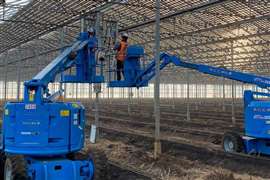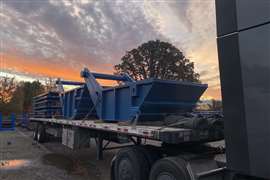Germany's construction outlook
29 October 2008

The German construction market continued along its path of recovery last year with construction growing albeit at a slower rate compared to 2006. Slower growth is expected again in 2008.
Despite German construction growing last year by +2,3% it was at a much slower rate compared to the boom seen in 2006 (+4,3%) after a decade of decline.
The rates of growth will be slower still when looking ahead to 2008 and 2009, according to economic forecasting group, Euroconstruct, which said in its latest report construction output will increase by +1,2% and +1,5% respectively.
The German market accounts for 15% of European construction activity and in 2007 it was valued at € 257 billion, the report added.
According to the European Construction Industry Federation's (FIEC) 2008 Construction Activity in Europe report, the highest growth rate in the three major sectors last year was achieved in commercial construction with a rise of +5,2%, followed by public construction with a rise of +3,0%, while residential construction was close to stagnation. It added it expects growth of +1,3% for construction in 2008, "driven mainly by the continued robust growth of commercial construction."
Mixed market
Heinrich Weitz, economic affairs consultant, for the Hauptverband der Deutschen Bauindustrie (HDB) - the federation of large German contractors - said the German construction market has shown mixed results in the past 12 months.
"This is due first of all to the rise in the normal VAT rate from 16% to 19% from the 1 January 2007, which meant a lot of turnover was taken into 2006 because investors wanted to avoid the higher VAT rate," he said.
Results are positive overall for the German construction market when looking at the past 12 months Mr Weitz said, although he added there are different lines of development in the various sectors.
"What we have seen and is still the case now is a good growth in commercial construction sector. This is mostly due to the fact that in the mid to late 1990s German companies went abroad - especially to middle and Eastern Europe - with their production lines in search of lower wages. Some of those companies have now come back to Germany due to the rise in wages especially in Czech Republic and Hungary. So what we are seeing now is a kind of a re-establishment of the production line in Germany."
He added from July 2007 to June 2008 there was a rise in turnover of +3,7% for commercial construction, +2,2% in public construction and a fall of -7,4% in the residential sector where demand is still weak. He said the poor performance in residential construction is mostly due to the VAT rise and the cancellation of the homeowner state subsidy at the end of 2005.
Looking at the first six months of 2008, from January to June, he said residential construction has declined by -0,2%, while in commercial and public construction there has been rise of +11,9% and +9,5% respectively. Construction output as a whole grew by +7,3%, Mr Weitz added.
New order figures, taken from construction companies with 20 employees or more, in residential construction, from January to June, show a decrease of -5,6%. Meanwhile, new orders in commercial and public construction have increased by +4,5% and +6,1% respectively and new orders in the market as a whole have grown by +3,5%.
Increasing interest rates, a weak housing market and a strong Euro, have yet to impact negatively on the German construction economy according to Mr Weitz.
He added, "We are seeing those risks, we are not turning a blind eye to them and saying everything is fine - they are there, but I don't see them in the figures. As long as we have positive figures for new orders and positive figures for commercial buildings I can't blame these risks for any downturn in the construction sector. It may change over the next part of the year but for the time being I can only say we are not bullish but we are looking at it positively."
Mr Weitz said the HDB forecast for the German construction sector as a whole is for +4% growth in 2008.
Regional review
Mr Weitz said performance of the three construction sectors is also different when looking at German regions. He added in certain spheres of construction activity and in some regions there is also a problem recruiting and retaining a skilled workforce.
Another problem stems from the large investments made in East Germany between 1990 and 1995 that resulted in over-capacity, and in the following years the East fell behind the West. "We saw them overcome that divide in 2006/07 but now we see it happening once again," Mr Weitz said.
The difference in regional activity is not that big when looking at the first five months of 2008, with +8,4% in the West and +5,5% in the East. But looking at new orders there is more of a marked difference with +4,6% in the West and -2,8% in the East, Mr Weitz said. He added the situation in Berlin is different because contractors are benefiting from construction work at the new airport.
"But for East Germany as a whole our expectations are not so positive this year and if we do see a growth next year it will clearly be behind the West," Mr Weitz added.
Equipment sector
Germany's equipment market fared well in the first half of 2007 but by the end of the year order intake started to decline according to Dr Peter Hug, deputy managing director for Verband Deutscher Maschinen und Angelbau (VDMA) - Germany's construction equipment and building machinery association.
Dr Hug added longer delivery times and good order backlog in the first half of 2007 has also helped buoy the German equipment market in the first half of this year.
Dr Hug said, "Domestic (equipment sales) growth is on a very high level and from that level we can't expect very much growth. Much of the growth came from the fact that used machinery was being exported to Poland and other Eastern European countries. These machines were replaced in Germany but this has now stopped because last year these (Eastern European) countries started to increase their investments in new equipment."
He added, "In addition Germany still faces replacement cycles caused by the reunification of the country. And the latest replacement phase seems to have ended now. This means that demand in the German market had to decrease and although this is not surprising, the surprise is that it has happened already. A turnaround is expected in the second half of 2008."
The VDMA said the German construction equipment market was worth € 3,1 billion in 2007.
"Despite the order backlog and the decrease in order intakes we still expect a +5% increase by the end of this year to € 3.25 billion. We expect, due to the missing orders, that next year Germany's construction equipment market as a whole will decrease by about -15%," Dr Hug said.
Germany's domestic house building equipment market saw a +21% increase in sales in the first half of 2008 and a -20% decrease in order intake, he added. For the domestic earthmoving equipment sector there was no change in sales and a fall of -39% in order intake. Germany's domestic road building machinery sector is also experiencing zero growth with a -30% decrease in order intake.
"That means to get the +5% at the end of the year (2008) sounds difficult but the order backlog makes this possible," Dr Hug said.
The best performing sector in the German equipment market is currently concrete machinery in the non-residential building sector, according to the VDMA.
In 2010 there will be a slight decrease in the market again by about -5%, Dr Hug said. "The market will then stabilise during 2010 or 2011 and it might be that in the second half of 2011 that there will be remarkable increase in the market again," he added.
Manufacturers
The uncertain German construction market up until 2005 meant companies held back on investments for "quite some time" Jürgen Martiens, director of sales for Bomag's German division told CE.
"In 2006 and 2007, demand exploded and the German market chalked up previously unseen rates of growth. At Bomag Germany we have always maintained a high level of activity on the market, and were consequently able to double our sales figures - a level which has been sustained in 2008."
However, he added, "We should assess the situation realistically. Doubling the turnover in two years and maintaining that level in the third year is bound to have an effect on the future. The market is currently saturated with machines, and now our customers need the right volume of orders. We have adjusted to the situation and are preparing ourselves for the increase in demand, which is sure to come. And we are constantly expanding our product range. This has always been and shall remain our recipe for success - to identify trends ahead of time."
However, compared with the previous year, demand in the rental sector is declining "which is clearly apparent from investment volumes in this area," he added.
In 2008 Bomag has witnessed an increase in investment by construction companies throughout the entire product range, although growth rates have been particularly noticeable in the light equipment sector, Mr Martiens said.
"In contrast there was a decline in demand on a global scale. Naturally this also had repercussions on the German market. Firstly, the cycle was interrupted because the demand for used equipment had declined internationally but also because rental companies were marketing used-equipment from their own machine fleets (in particular their high-end value products) to then subsequently rejuvenate the fleet with new equipment. Secondly, the demand from rental companies halved - a factor that was certainly noticeable."
In the compaction technology sector, Mr Martiens said Bomag is very dependent on the supply of funds from the public purse as their customers live off road construction in all its forms, which is subsidised by up to 99% from such funds.
"To put it briefly, the global banking crisis exerts a very strong influence," he added.
Meanwhile, Carl Gustaf Göransson, president of Volvo Construction Equipment in central Europe, told CE the total market for large equipment in Germany between June 07 and June 08 has grown between +8% and +10%. Small equipment however, has slowed down in the first half of this year with compact excavators seeing a decline of -10% to -15%, he said. However, he added there is still a strong growth of compact wheel loaders by +15 to +20% and models up to 100 hp have seen an increase of +12 to +15% in the first half of this year. Mr Göransson said he attributes the overall decline in light equipment to the record volumes achieved in 2007.
"If I talk in general we see equipment such as crawlers, excavators and mini excavators coming down from record volumes and there have been excessive investment in the rental sector and this has by itself caused a cooling off in demand."
But he said Volvo sees this as part of the normal cycle of demand.
Meanwhile, promoting its new road machinery business is one of the biggest and most important tasks for Volvo in Germany, according to Mr Göransson.
"We are transferring this business to our distribution as we speak. We are confident that we will be able to support the existing paving and roller equipment and also to be able to meet new customers," he added.
Paving equipment is the focus for the German market he said but road compaction equipment will also present some interesting opportunities for the rental business.
Outlook
Economic forecasters agree that overall construction activity in Germany is expected to grow in 2008, albeit at a slower rate than 2007. The commercial sector in particular will help to boost the weak performing residential market.
After an unsettled period in Germany's construction market Euroconstruct predicts a period of sustained growth of +1,5% in 2009 and 2010. Despite it being only a small development, could this suggest a return to a more stable market, which in turn, could act as a platform for further and more significant growth? Only time will tell.






